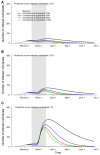Estimation of the Excess COVID-19 Cases in Seoul, South Korea by the Students Arriving from China
- PMID: 32365703
- PMCID: PMC7246702
- DOI: 10.3390/ijerph17093113
Estimation of the Excess COVID-19 Cases in Seoul, South Korea by the Students Arriving from China
Abstract
Background: In March 2020, overall, 37,000 international students from China, a country at risk of the 2019-novel coronavirus (COVID-19) infection has arrived in Seoul, South Korea. Individuals from the country at risk of COVID-19 infection have been included in the Korean home-quarantine program, but the efficacy of the program is uncertain. Methods: To estimate the possible number of infected individuals within the large influx of international students from China, we used a deterministic compartmental model for epidemic and performed a simulation-based search of different rates of compliance with home-quarantine. Results: Under the home-quarantine program, the number of the infected individuals would reach 40-72 from 12 March-24 March with the arrival of 0.2% of pre-infectious individuals. Furthermore, the number of isolated individuals would peak at 40-64 from 13 March-27 March in Seoul, South Korea. Our findings indicated when incoming international students showed strict compliance with quarantine, epidemics by the international student from China were less likely to occur in Seoul, South Korea. Conclusions: To mitigate possible epidemics, additional efforts to improve the compliance of home-quarantine of the individuals from countries with the virus risk are warranted along with other containment policies.
Keywords: COVID-19; Korea; compliance; coronavirus; quarantine; simulation.
Conflict of interest statement
The authors declare no conflict of interest.
Figures



References
-
- The Korea Times Korea to Ban Entry from Visitors from Hubei Province. [(accessed on 26 March 2020)]; Available online: https://www.koreatimes.co.kr/www/nation/2020/02/119_282795.html.
-
- Korean Ministry of Health and Welfare . Response Guideline for 2019 nCoV. Korean Ministry of Health and Welfare; Sejong, Korea: 2020.
-
- Ilbo D. The Suspected Patient of COVID-19 Met His Family on His Self-Quarantine Period. [(accessed on 23 March 2020)]; Available online: https://www.yna.co.kr/view/AKR20200214148700017.
Publication types
MeSH terms
LinkOut - more resources
Full Text Sources

